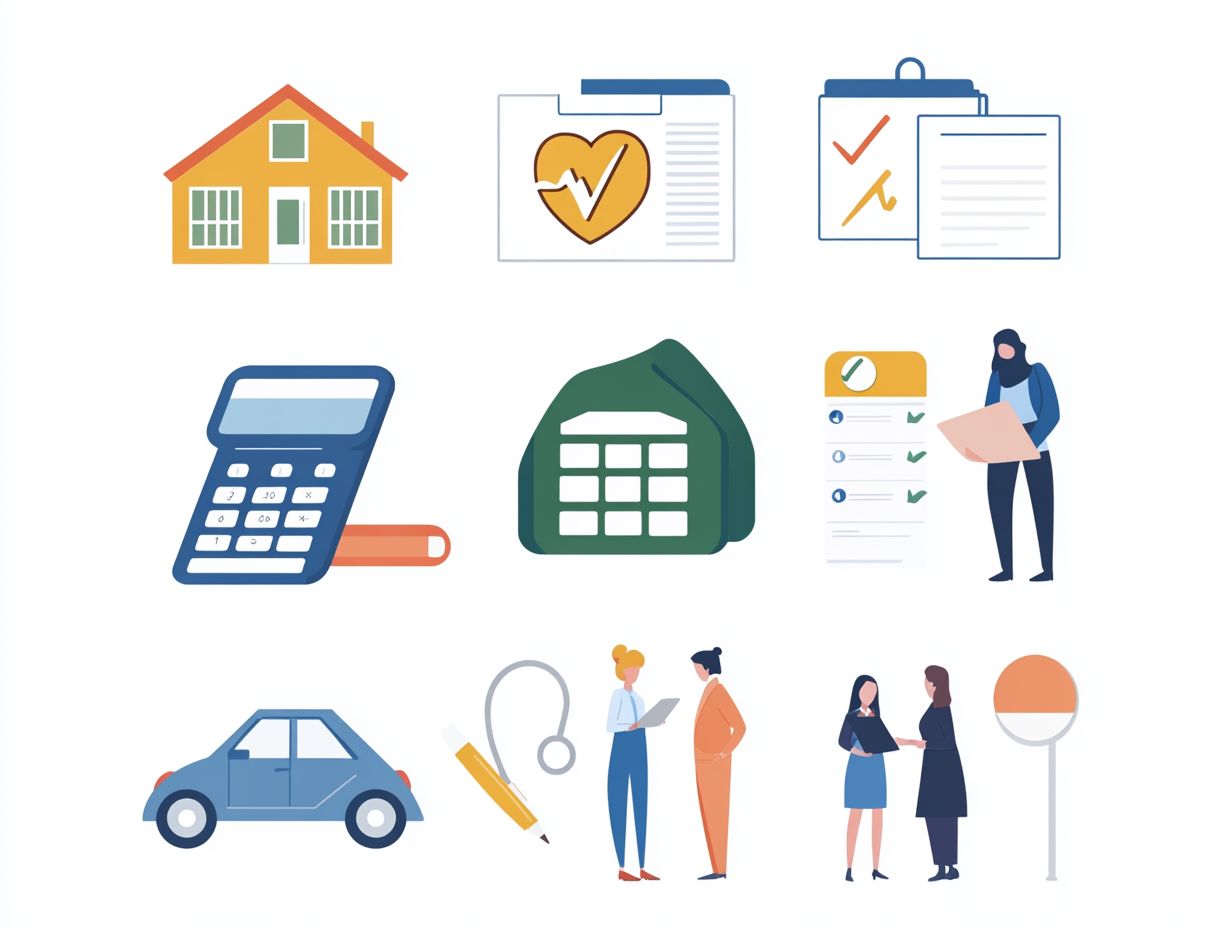Top 10 Factors Influencing Your Insurance Premium
Navigating the world of insurance can feel overwhelming, especially when trying to grasp what influences your premiums.
Factors like your age, health, location, and lifestyle significantly impact how much you pay for coverage. This article delves into the top 10 factors that shape your insurance costs, providing valuable insights into personal habits and market trends.
By gaining a clear understanding of these elements, you can make more informed decisions and potentially reduce your premiums. Explore how you can take charge of your insurance expenses!
Contents
- Key Takeaways:
- Top 10 Factors Influencing Your Insurance Premium
- 1. Age and Gender
- 2. Health and Medical History
- 3. Occupation and Income
- 4. Location and Environment
- 5. Marital Status and Dependents
- 6. Type and Coverage of Insurance
- 7. Lifestyle and Habits
- 8. Credit Score and Financial Stability
- 9. Claims History
- 10. Type of Vehicle (for Car Insurance)
- 11. Security Features of Property (for Home Insurance)
- 12. Risk Factors Associated with Activity (for Life Insurance)
- 13. Level of Coverage and Deductible Amount
- 14. Discounts and Incentives
- 15. Market Trends and Competition
- Frequently Asked Questions
- 1. What are the top 10 factors that can influence my insurance premium?
- 2. How does my age affect my insurance premium?
- 3. Does my driving history impact my insurance premium?
- 4. Can my credit score affect my insurance premium?
- 5. How does my location affect my insurance premium?
- 6. Will my premium be affected by the type of coverage I choose?
Key Takeaways:

- Your age and gender can greatly impact your insurance premium.
- Your lifestyle choices and habits can affect the cost of your insurance.
- Your claims history and credit score can influence the price of your insurance.
Top 10 Factors Influencing Your Insurance Premium
Understanding the various factors that influence your car insurance premium is essential for making informed decisions. Elements such as your driving record and credit history play significant roles in determining your premium.
Your claims history also affects your rates. Age and marital status also affect your rates.
The type of vehicle you drive, the coverage options you select, and your geographic location further influence your overall insurance costs. Being aware of these variables enables you to navigate the insurance market with greater finesse.
Take vehicle type, for example: sports cars usually come with higher premiums due to their increased risk of theft and accidents. A safe, fuel-efficient sedan might attract more favorable rates. Your location is another critical factor; urban residents in bustling areas often face steeper premiums because of the heightened likelihood of accidents.
Don t overlook the discounts available to you. Bundling policies, maintaining a spotless driving record, and completing defensive driving courses are all savvy strategies to significantly reduce costs. By mastering how to leverage these factors, you can negotiate better rates and secure more affordable coverage.
1. Age and Gender
Age and gender are critical factors that insurance companies weigh heavily when calculating your car insurance rates. This often results in notable differences in premium costs.
If you re a younger driver, especially in your late teens or early twenties, expect to see significantly higher premiums compared to older drivers. Statistical data shows that less experienced drivers tend to be involved in a disproportionate number of accidents.
Gender also plays an important role; male drivers, particularly in younger age groups, are generally viewed as higher risk due to a greater likelihood of engaging in risky driving behaviors.
Insurance providers meticulously analyze these demographics to set your rates, reflecting broader statistical trends while striving to accurately assess risk.
2. Health and Medical History
While health insurance is the obvious focus, your health and medical history can subtly influence your car insurance rates and the policies available to you.
This connection becomes particularly clear when you consider how certain medical conditions can impact your driving abilities. Conditions like epilepsy, vision impairment, or cognitive decline can seriously affect road safety, and insurers take this matter very seriously.
As a result, when insurance companies assess your qualifications and how likely you are to make a claim, they may delve into your medical records. If these health issues correlate with a poor driving record, filled with accidents or traffic violations, you may end up with steeper premiums.
Prioritizing good health not only promotes safer driving but also helps keep your insurance costs under control.
Take a moment to review your insurance options or seek quotes based on these factors discussed!
3. Occupation and Income
Your job and income level significantly impact your car insurance rates. Insurance providers examine the link between job types and driving risk closely.
For instance, if you’re a teacher, accountant, or healthcare professional, you often find yourself in a lower-risk category. This translates to more affordable premiums.
These roles typically involve stable hours and less time spent on the road, reducing the chances of accidents. On the flip side, if you work in construction, trucking, or emergency services, you might face higher insurance costs due to frequent driving in potentially hazardous conditions.
Income levels also play a crucial role. Those with higher earnings may have access to better coverage choices, while those earning less might find it challenging to secure basic policies.
This dynamic highlights the complexity of navigating insurance markets shaped by both occupation and financial standing.
4. Location and Environment
The location where you reside significantly influences your car insurance rates. Urban areas generally face higher premiums due to a greater frequency of accidents.
In bustling cities, you encounter factors like heavy traffic, limited parking, and an increased likelihood of collisions. All of these create a more hazardous driving environment.
In contrast, rural areas tend to have fewer vehicles on the road, resulting in lower accident rates. Don’t overlook how state regulations can dramatically shape your insurance costs!
Local laws regarding auto insurance coverage requirements can vary considerably, impacting pricing strategies. Areas with higher crime rates, often found in urban settings, may further inflate your insurance costs, as the risk of vehicle theft or vandalism becomes a more pressing concern.
5. Marital Status and Dependents

Your marital status and whether you have dependents can play a significant role in determining your car insurance rates. Insurers often consider married individuals and parents to be lower-risk drivers.
Statistical data shows that married couples generally demonstrate more responsible driving behaviors. As a result, insurance providers often reward these individuals with discounts on their premiums, acknowledging the stability that family life brings.
When you have dependents, you re seen as having more at stake. This can encourage safer driving habits and lead to lower insurance costs.
This added sense of responsibility contributes to an overall risk assessment that favors those committed to their families.
6. Type and Coverage of Insurance
The type and level of insurance coverage you select can significantly affect your premium costs. Full coverage generally leads to higher rates compared to minimum coverage policies.
By exploring the various options available, you can make informed decisions tailored to your unique circumstances. For instance, insurance for damages to others is vital for many drivers, protecting against damages inflicted on other parties in an accident.
Collision insurance takes care of repair costs for your own vehicle, providing you with peace of mind should an accident occur. Personal injury protection ensures that medical expenses related to an accident are covered, no matter who is at fault.
It s also essential to weigh how your choices regarding deductibles the amount you pay out-of-pocket before insurance kicks in and coverage limits can influence your insurance premiums. Opting for higher deductibles often results in lower monthly payments, but it means you might face more out-of-pocket expenses when filing a claim.
7. Lifestyle and Habits
Your lifestyle and driving habits play a crucial role in how insurance providers assess your risk profile and potential for filing claims.
The frequency of your travel can significantly indicate your risk level as a driver. For instance, commuting daily through bustling urban streets or frequently taking long road trips can lead insurers to classify you differently than someone who drives only occasionally for leisure.
If you choose usage-based insurance plans, your premiums adjust based on your actual driving behavior, rewarding you for safe practices. With technology that tracks your driving habits, you gain insights that can positively influence your costs.
Ultimately, the choices you make like opting for public transportation or eco-friendly travel also shape how insurance providers evaluate and calculate your risk.
8. Credit Score and Financial Stability
Your credit score and overall financial stability significantly impact your car insurance rates, as many providers rely on credit history to assess risk factors.
Insurers evaluate your credit profile to measure the likelihood of timely premium payments and potential claims. This leads to a more customized insurance quote tailored just for you. Strong credit histories often position individuals for various discounts, reflecting their perceived reliability.
A favorable credit score can streamline the insurance approval process, possibly resulting in lower costs and more appealing coverage options. Maintaining your financial health boosts your chances of securing competitive insurance and enables you to make informed decisions that safeguard your long-term investments.
9. Claims History
Your claims history plays a pivotal role in determining your insurance rates. A record filled with multiple claims can lead to higher premiums and complicate your quest for favorable coverage.
Insurers perceive drivers with numerous claims as higher risk, prompting them to adjust rates accordingly. This view can make it harder for you to find the best policy options, such as those featuring lower deductibles or additional benefits.
Fortunately, many insurance companies offer accident forgiveness programs designed to lessen the financial blow of a first accident, allowing you to maintain better rates even after minor mishaps.
Maintaining a clean claims record opens the door to these beneficial programs and qualifies you for good driver discounts, ultimately reducing your insurance costs over time.
10. Type of Vehicle (for Car Insurance)
The vehicle you choose whether it’s a standard model or a high-performance sports car can significantly influence your insurance rates. Different vehicles come with distinct risk factors.
For example, cars equipped with advanced safety features often benefit from lower premiums due to their reduced risk of accidents and injuries. On the other hand, flashy sports cars, which tend to draw attention and encourage risky driving behaviors, typically result in higher insurance costs. Similarly, luxury vehicles, with their pricey parts and heightened theft risk, often lead insurers to adjust premiums upward.
Therefore, consider not just the purchase price of your vehicle, but also how its type and features can affect the overall cost of your insurance.
Take a moment to evaluate your driving habits and credit score they could save you money!
11. Security Features of Property (for Home Insurance)

While you’re focusing on car insurance, don t overlook how the security features of your property can impact your home insurance costs. These elements can significantly reduce both risk and premiums.
A well-secured home, equipped with alarms and surveillance cameras, does more than just protect your belongings. It sends a strong message to insurers that the chances of theft or damage are much lower.
This encourages many providers to offer reduced rates for homeowners who prioritize these protective measures.
The presence of security features can enhance the range of insurance products available to you, possibly allowing you to qualify for additional discounts or benefits tailored to your commitment to safety.
In essence, investing in security isn t just about peace of mind; it s a savvy financial strategy that can lead to substantial savings on your home insurance.
12. Risk Factors Associated with Activity (for Life Insurance)
While your primary focus may be on car insurance, understanding the risk factors associated with various activities can provide valuable insights into how life insurance premiums are determined and influenced.
For example, if you engage in high-risk hobbies like skydiving, rock climbing, or extreme sports, you could significantly elevate your risk profile. Insurers take a deep dive into your lifestyle choices, considering factors such as smoking, drinking habits, and even occupational hazards.
As they compile this information, they assess not just the likelihood of health-related claims but also the potential for premature death.
By evaluating these various elements, life insurance providers meticulously calculate premiums that reflect your overall risk level. This ultimately leads to tailored insurance rates that align with your unique circumstances.
13. Level of Coverage and Deductible Amount
The level of coverage you choose, along with your selected deductible amount, significantly impacts your insurance premiums, often presenting a trade-off between lower rates and sufficient protection.
Striking this balance is essential for you as a policyholder. Opting for a higher deductible can reduce your premium, freeing up financial resources for other expenses. However, this decision requires careful consideration, as a higher out-of-pocket expense during a claim could strain your budget.
Many insurance providers offer discounts for taking on higher deductibles, potentially making your policy more affordable in the long run. By understanding the implications of these choices, you can manage your coverage effectively, ensuring you receive the best possible value for your insurance investment.
14. Discounts and Incentives
Insurance providers frequently extend a range of discounts and incentives that can significantly reduce your premium costs, effectively rewarding your safe driving habits and commendable credit history.
These savings may manifest as good driver discounts, which acknowledge those who maintain a spotless driving record, or claim-free discounts that benefit individuals who haven’t filed any claims over a specific timeframe.
Check your insurance policy to see if you qualify for these exciting discounts. You could find substantial savings that make insurance not only more affordable but also encourage responsible behavior on the road.
15. Market Trends and Competition
Market trends and competition among insurance companies significantly influence your insurance rates. Changes in the insurance market often lead to various offers and pricing strategies that can affect what you pay.
Recently, the rise of technology has introduced innovative factors like telematics, a technology that uses GPS and onboard diagnostics to monitor driving habits, and usage-based insurance. These developments allow you to receive personalized rates based on your driving behavior, making it easier for insurers to assess risk accurately.
You can easily discover the best deals tailored to your unique needs and preferences by comparing insurance rates. This enables you to make informed decisions that could lead to significant savings. Start comparing rates today to save on your insurance!
Frequently Asked Questions

The top 10 factors that can influence your insurance premium include your age, gender, driving history, credit score, location, type of coverage, deductibles, vehicle make and model, annual mileage, and top factors affecting auto insurance rates.
Generally, younger and older individuals tend to have higher insurance premiums due to a greater likelihood of accidents. Younger drivers may have less experience, while older drivers may have slower reflexes.
Yes, your driving history plays a significant role in determining your insurance premium. A history of accidents, traffic violations, or DUIs may categorize you as a high-risk driver, resulting in a higher premium.
Yes, your credit score can impact your insurance premium. Insurance companies often use credit scores to predict the likelihood of filing a claim. A lower credit score may lead to a higher premium.
Your location can affect your insurance premium in various ways. Living in an area with a high crime rate or heavy traffic can increase your premium. Some states have higher insurance requirements, which can also raise your premiums.
Yes, the type of coverage you choose will impact your insurance premium. For example, comprehensive coverage typically has a higher premium than liability coverage alone. It s important to select coverage that fits your needs and budget.






